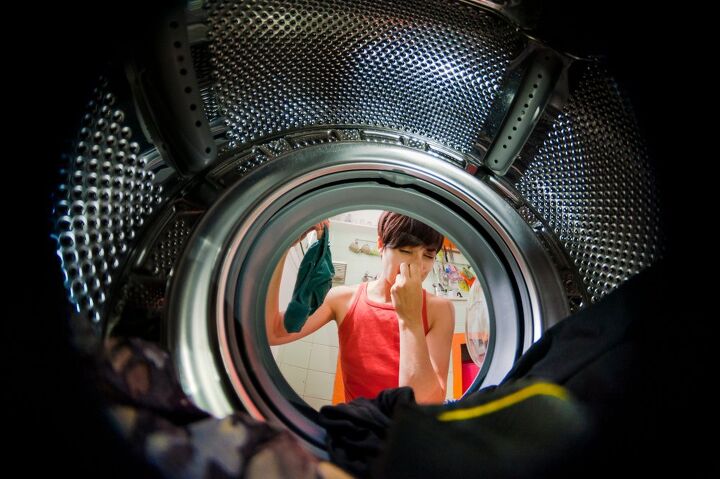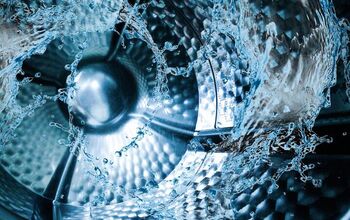Why Does My Washing Machine Smell Like Rotten Eggs? (Find Out Now!)

Doing laundry isn’t usually a fun chore, and a bad smell coming from your washer can make it even worse. Your washing machine is meant to clean your laundry, so why does it smell?
If your washing machine smells like rotten eggs, you must get to the root of the problem quickly. This smell often indicates the growth of mold, mildew, and bacteria. This could be harmful to you and your family and could indicate that your washer is in need of repair.
Keep reading to learn more about what may be causing the rotten egg smell, and how to fix it quickly!
Do You Need a Maid Service?
Get free, zero-commitment quotes from pro contractors near you.

What Causes the Rotten Egg Smell?
Hydrogen sulfide gas, which tends to give off a rotten egg smell, is the result of metabolizing bacteria. This occurs when buildup accumulates in your washing machine, from soap scum and dirt to mold and mildew.
Hydrogen sulfide gas can be harmful to you and your family. However, getting rid of that rotten egg smell is often as simple as thoroughly cleaning your washer.
Clean Your Washing Machine
If you haven’t been maintaining your washing machine, it might simply be due for a good cleaning. Consider taking the steps below to clean several components of your washer.
Clean the Rubber Seal
Most front-loading washing machines contain rubber seals around the door. This seal can collect buildup over time, leading to mold, mildew, and bad smells. Here is how to clean the rubber seal on your front-loading washing machines:
- Begin by pulling back the rubber slightly to check for small items of laundry that could’ve gotten stuck.
- Mix together a solution of equal parts apple cider vinegar and water in a spray bottle.
- Spray the vinegar mixture onto the seal.
- Allow the spray to sit on the rubber seal for a few minutes.
- If the rubber seal contains a lot of visible buildup and residue, use a cleaning brush or cloth to scrub the seal.
- Wipe down the seal with a clean, dry towel.
If you frequently use your washing machine, you should check for items trapped behind the rubber seal almost every time you use your washer. You should wipe down the rubber seal weekly to keep buildup at bay.
Over time, the rubber seal can become warped or damaged. If it is not cleaned regularly, it can become dirty beyond repair. In this case, it is a good idea to replace the seal. Be sure to order the correct part for your washing machine model.
Clean Out The Filter
Did you know? Just like a dryer, most washing machines contain a filter that also needs to be cleaned regularly. One of the purposes of this filter is to catch large items and debris. This prevents these items from making their way into other washing machine parts and causing damage.
Here’s how to clean your washing machine’s filter:
- Unplug your washing machine.
- Locate the filter. It is usually covered by a small square hatch on the bottom corner of the front of your washing machine.
- Remove the cover. If your washing machine contains a childproof cover that is more difficult to remove, use a screwdriver to gently pry off the cover.
- Place a small bowl or container beneath the filter to catch any water or debris that might spill out.
- Pull out the round filter.
- Using a clean towel, wipe down the screen to remove lint.
- Remove the screen and soak it in hot water.
- Check to ensure there is no debris left inside the machine. Use a wet cloth to remove any buildup.
- Put the filter and screen back together, and put it back into place.
- Put the filter cover back on.
- Plug your washing machine back in.
Run a Cleaning Cycle
Some washing machines do not contain a filter that needs to be cleaned. Instead, a cleaning cycle will do the trick. If your washing machine contains a self-cleaning cycle, be sure to run this once per month, or more often.
If your washing machine does not contain a built-in self-cleaning cycle, here’s how to clean a top-loading washing machine:
- Set the water to the hottest setting and press start.
- As the washer is filling up, add 4 cups of bleach to the tub.
- Allow it to complete the spin cycle for 5-10 minutes.
- Pause the cycle and allow the bleach to soak in your washer for 30 minutes to an hour.
- Resume and finish the wash cycle.
- Run a rinse and spin cycle to get rid of any remaining bleach.
- Repeat the same process with white vinegar.
Clogged Drain Pipe
Every washing machine contains a drain pipe that carries out the dirty water from the washing machine and into the rest of your home’s wastewater. Sometimes, this pipe can become clogged with buildup and debris. This will cause water to sit and become smelly, rather than draining properly.
- Unplug your washer.
- Move your washer away from the wall for easier access.
- Place a bucket or large container beneath the drain hose to catch the water that will spill out.
- Unscrew the drain hose from the drain pump.
- Loosen any clamps holding the hose in place.
- Allow excess water to drain out of the hose into the bucket.
- Disconnect the opposite end of the hose, connected to the standing pipe.
- Use a drain snake to remove any debris that might be clogging the hose.
- Transfer the hose to a sink or bathtub. Run hot water through the drain hose until it runs clear.
- Reconnect the hose and put all clamps back in place.
- Move your washer back into place.
- Plug your washing machine in.
You should clean out your washing machine drain hose every six months. Ensuring that your washing machine is draining properly is key to extending the life of your washer. The hoses should also be replaced every 5 years. Use a piece of tape to label hoses with their date so that you can remember when to replace them.
Clogged Vent Pipe
A vent pipe is a pipe for your washer’s standing pipe that lets air into the system. This allows the water to flow freely and provides an escape for unpleasant and smelly sewer gases. If this pipe is clogged, the sewer gases will back up into your home.
Because the vent pipe often goes out to the roof, you’ll only be able to clean this yourself if it is safe to get onto your roof. If you don’t feel comfortable doing this on your own, contact a professional.
Dried P-Trap
If your washer has been cleaned and doesn’t seem to have any other problems, it could be a sewer problem.
Every drain in your home contains a p-trap. This is located at the bottom of your standpipe. It is called a p-trap for its curved shape that looks like the letter ‘p’. The p-trap will catch debris to prevent damage to your home’s sewer system. It also contains a small amount of water that creates a barrier to prevent bad-smelling sewer gases into your home.
If your washing machine’s p-trap becomes dried out and no longer contains water, sewage gasses can leak back into your home. Often these gasses create a smell like rotten eggs.
Here’s how to fix this problem on your own:
- Unplug your washing machine
- Disconnect the drain hose from the standing pipe.
- Pour a gallon of water down the standing pipe.
- Reconnect the drain hose and plug your washer back in.
If you complete these steps and the sewage smell persists after a few days, contact a plumber to inspect your washing machine’s drainage system.
Related Questions
How Often Should You Clean Your Washing Machine Filter?
It is recommended that you clean out your washing machine filter every 3-4 months. This will keep your washing machine running properly, and prevent damage to other components of your washer.
Do Washing Machine Cleaner Tablets Actually Work?
Brands like Affresh and Oxi Clean offer tablets that claim to clean your washing machine. Using these tablets once a month can be good for your washer. However, you’ll still need to clean parts like hoses and the rubber seal. There are also more inexpensive cleaning methods, like vinegar or baking soda, that will get your washing machine just as clean.
Is it Safe to Use Dishwasher Tablets to Clean your Washing Machine?
A viral cleaning hack claims that you can use dishwashing tablets to clean your washing machine. It seems to be working for many people and can make your washer appear clean. However, dishwashing tablets are designed to be used with higher-temperature water than your washer can usually provide. This means that the dishwashing soap might not fully dissolve in your washer, and may leave behind some residue instead.
Do You Need a Maid Service?
Get free, zero-commitment quotes from pro contractors near you.

Conclusion
In many cases, getting rid of a rotten egg smell is as simple as thoroughly cleaning your washing machine. Even if there is a bigger issue, it can often be solved at home with a simple fix. Of course, if you don’t feel comfortable doing repairs on your washing machine yourself, always consult a professional.

Dakotah Forbes is a copywriter and content writer specializing in home decor and design. She is dedicated to helping readers find answers to all their home design questions by creating helpful guides and articles. In her spare time, she loves to use her creative spirit to complete her own home decor and DIY projects. Dakotah graduated from James Madison University with a BA in Media Arts and Design and currently resides in Virginia with her husband.
More by Dakotah Forbes



























